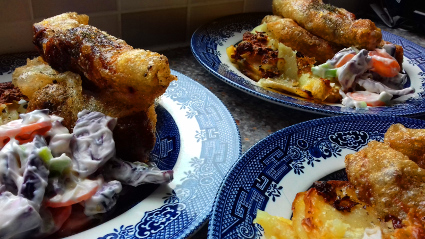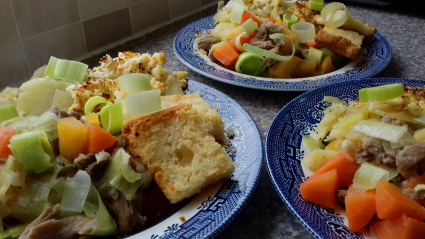- Details
- Written by Tony Carson
- Category: Recipes

We’ve been playing at Around The World for £4 Or Less again. We’re having a bit of trouble with a nation beginning with “X” So we moved on to The Republic of Yemen for “Y”
This dish is traditionally served for Breakfast with poached or scrambled Egg, we’re guessing they’re not big on lunch in The Yemen – this was a very well flavoured and filling meal!
Ingredients:-
1 Sheep Liver, chopped
1 Red & 1 Green Bell Pepper, chopped
1 Onion, chopped
1 Tomato, chopped
1/2 cup Tomato Puree
¼ tin of chopped Tomatoes
2-3 Red Chillies
1 tsp. Hawaij Spice mix (See below)
3 Cloves of Garlic, minced
2 tbsp. Oil
1/4 tsp. Salt
An Egg each
Ingredients for the Hawaij Spice mix:-
2 tbsp Cumin Seeds
1 tbsp Caraway Seeds
1 tbsp Coriander Seeds
1 1/2 tbsp Ground Turmeric
1 1/2 tbsp Black Peppercorns
2 tbsp Cardamom Pods
Method for the spice mix:-
(1) Lightly toast the Cumin, Caraway and Coriander seeds over medium heat for 1-2 minutes until fragrant.
(2) Grind all the ingredients once cooled in a coffee grinder or food processor.
Method:-
(1) Fry the Onions in Oil over medium-high heat. When the Onions start to brown, add the Garlic and Chilli. Cook for about 30 seconds until the Garlic is fragrant.
(2) Add in the chopped Liver and brown this on all sides.
(3) Add the tomato Puree, chopped Tomatoes, Hawaij, and salt. Mix together and cook until the Liver is nearly cooked through, about 15-20 mins.
(4) At the end, add in the Bell peppers and cook for a few minutes more, until the Peppers are cooked through.
(5) Fry an Egg and serve over your Kebda
You might want to serve with a little toasted bread, but we really didn’t think it needed it.
- Details
- Written by Tony Carson
- Category: Recipes

We bought these Rice Wafers from the local Chinese Supermarket. They’ve sat in the draw for months. The main problem is that we thought we could use them as replacements for Wanton Wraps which are Wheat based (Not good for Sue) and the basis of your more traditional Spring Roll. WRONG!
As soon as you soak them in warm water they curl up and weld together in an very annoying clump! So as an experiment I whisked a couple of eggs, dunked the Rice paper disks in tepid water and then egg washed them. Yay it worked!!!! They don’t stick together but the parcels remain intact when you fry them.
I stuffed ours with some shredded left over cooked Chicken, Soy Sauce (Too much actually) grated Carrot, Lettuce etc. They were quite convincing to be fair. Served with the left over Welsh Potato Cake and a thrown together Coleslaw it was a bit of a mongrel dinner, but quite good.
- Details
- Written by Tony Carson
- Category: Recipes

With Sue here “W” on our Around The World for £4 gig was always going to be Wales. So Cawl & Welsh Potato Cake it was! The Lamb neck was actually more likely to have been Mutton neck from our friendly local Continental shop. But as they generally throw it out it cost us the grand sum of £0.70 to cover the cost of the bag….
Ingredients (Cawl):-
1 Onion
1 kg lamb neck , bone in, cut into 5cm chunks if you can. If not you can strip the meat once it’s cooked. (Buster enjoyed the bone!)
1 kg Swede
2 Carrots
2 Parsnips
500g Maris Piper potatoes
1 1/2 large Leeks
Mature Caerphilly cheese , to serve. (Or a similar crumbly white cheese)
2 Stock Cube dissolved in 500ml of water
Plenty of Salt & Pepper
Method:-
(1) Pour 2 litres of water into a large pan with 2 teaspoons of salt, then bring to the boil over a high heat. Peel and add the whole Onion, along with the Lamb.
(2) Bring back to the boil. Simmer on a medium heat for 10 to 15 minutes, or until the Lamb is cooked through.
(3) Using a slotted spoon, remove the Lamb to a plate and leave until cool enough to handle.
(4) While it’s cooling, peel the Swede, chop into 1cm chunks, and add to the pan to get a head start. Peel the Carrots and Parsnips, slice at a slight angle 1cm thick, and drop them into the pan. Now peel the Potatoes and cut into 4cm chunks. Add the Stock to the pan.
(5) Strip all the Lamb meat from the bone, and return the meat to the pan with the Potatoes. Bring back to the boil, then simmer it all for 15 to 20 minutes, or until almost tender, while you wash the Leeks and cut them into 1cm-thick slices.
(6) Stir the leeks into the pan, bring to the boil again, then simmer for 10 minutes with the lid on, or until tender. Taste and season as required.
(7) Ladle into serving bowls and serve with lots of black Pepper, a wedge of mature Caerphilly cheese and a slice of bread and buitter (Home made Gluten free in our case) for dunking.
Ingredients (Welsh Potato Cakes):-
1 Onion
½ a Leek
1 very large Potato
Oil and Margarine to fry
Salt & ground Black Pepper
Caerphilly cheese, grated
Method:-
(1) Slice the Onions, Leeks and Potatoes.
(2) Fry the Onions and Leeks together
(3) Fry the Potatoes separately
(4) Layer Potatoes, then Onions and Leeks. Sprinkle with grated Cheese Salt and Pepper.
(5) Repeat the layers ending with Cheese on the top.
(6) Place in the oven at 180c for about 40 minutes until browned and crispy on the top.
- Details
- Written by Tony Carson
- Category: Recipes

Last night we had a roast Chicken dinner, Nothing new there. We generally cook like your granny did. It's cheap, it's good for us and Buster and it's not supplied in a shed lead of plastic. But sometimes we had leftovers.
What do you do with a small box of cooked Veg and Chicken?
Soup - for a rainy day.
Ingredients:-
1 Stock Cube (Or stock from a previous roast)
Left over bits and bobs (Veg and Chicken in this case)
Method:-
(1) Get the blender off the top of the freezer.
(2) Bring the stock cube (Or real stock if you have it) to the boil.
(3) Smash everything up in the blender.
If the Chicken wisn't previously frozen you can pop your soup directly in the freezer. A few herbs and a bit of fresh ground Black Pepper and you've got a meal for the cost of a Stock Cube. So 5p each maybe?
- Details
- Written by Tony Carson
- Category: Recipes

We have open herb beds nearby provided by Edible York. This isn’t an exact recipe as such. But as there are plenty of herbs free which we would only have access to dried, we’ve been experimenting.
Ingredients:-
Pork Shoulder (Clearly!)
All sorts of herbs
Chive Flowers
Various vegetables
Ingredients for Chive Flower Pesto:-
A handful of Chive heads cut into quarters from the stem to the top
2 Tbsp Yellow Lentils simmered to soften.
1 clove of Garlic grated
Salt & Pepper
Oil
A Splash of distilled Vinegar
Seasoning & Roasting Method:-
(1) Rub the whole of the exterior of the joint with home made Garlic Butter (Margarine actually) and Salt & Pepper.
(2) Cover in the fridge overnight.
(3) Pre heat the oven to 160C
(4) Dress the top of the joint with fresh Fennel tops, Chive Flowers and sit it on a sprig of Rosemary.
(5) Cover tightly and roast for 2 hours or so.
(6) Leaving the oven on remove the Pork and cut the skin off. This can be crisped under the grill for crackling.
(7) Spread the Chive Pesto over the meat and place back in the oven uncovered for a further 20 minutes.
We served ours on Yorkshire puddings with lots of veg and gravy. We think the Pesto would probably work as well if not better used as a stuffing where the bone was. We’ll be trying that option next time. The combination of herbs added a very nice fresh flavour to the meat.
© 2025 Eat Well on UC


